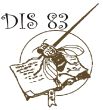
Drapeau, Mark D., and Anthony D. Long. 2000. The Copulatron, a multi-chamber apparatus for observing Drosophila courtship behaviors. Dros. Inf. Serv. 83: 194-196.
|
|
|
|||
The Copulatron, a multi-chamber apparatus for observing Drosophila courtship behaviors.
Drapeau, Mark D., and Anthony D. Long. Department of Ecology and Evolutionary Biology, University of California, Irvine, CA, 92697.
When studying behaviors, an experimenter should control as many aspects of the physical environment as possible. This is because behaviors, in general, are especially sensitive to the environment, making them relatively difficult to study. In addition, courtship and mating behaviors are difficult to study because by definition they involve studying the interaction between two sets of behaviors – those of males and those of females. Hence, the simplest case is that of a single male courting a single female. Recently, we have become interested in studying such 1♂:1♀ behavioral interactions, and we designed an apparatus within which we can observe numerous such interactions while at the same time controlling many aspects of the environment. This apparatus, called the “Copulatron”, also has additional helpful features, which are outlined below. Its primary advantage is that it offers multiple identical mating chambers, unlike many mating arenas described in the literature, which have only a single chamber (e.g., Elens and Wattiaux, 1964; McRobert and Tompkins, 1985; Welbergen, 1991). Having multiple chambers is advantageous for experi-ments where high sample sizes are needed, such as in the field of quantitative genetics.
|
|
|
Figure 1. Top view of the Copulatron base. The Copulatron is 11” ´ 11” square. Note the four metal posts at the corners, which the other pieces of the Copulatron are fitted over. The interior of each post is grooved so that a screw can be fitted through all pieces of the Copulatron and screwed into the base (see Figure 3). Note also the lightly-colored plastic spout on the left, which allows CO2 to flow into the chambers through the base. Finally, note the 36 cubic columns on the base of the Copulatron, which provide overall support for the upper structure. |
|
|
|
Figure 2. A, Top view of one of two pieces of the Copulatron which contain the mating chambers. Note the four holes in the corners which allow the metal posts from the base to be fitted through (see Figure 1). The smaller inner holes allow extra screws to be utilized. The piece is 11” ´ 11” square. B, Close-up view of four mating chambers from Figure 2A. Note the small antechamber, within which fly media can be placed. The diameter of each mating chamber is approximately 1-inch, and the diameter of each antechamber is approximately 1/4 -inch. |
|
|
|
Figure 3. The
fully-constructed Copulatron (minus top glass sheet). |
Acknowledgments: We thank the NIH for funding which made this project possible, and Rudy Limburg in the Biological Sciences Machine Shop at the University of California – Irvine for assisting with design and construction of the Copulatron.
References: Elens, A.A., and J.M. Wattiaux 1964, Dros. Inf. Serv. 39: 118-119; McRobert, S.P., and L. Tompkins 1985, Dros. Inf. Serv. 61: 194; Welbergen, Ph. 1991, Dros. Inf. Serv. 70: 262-263.